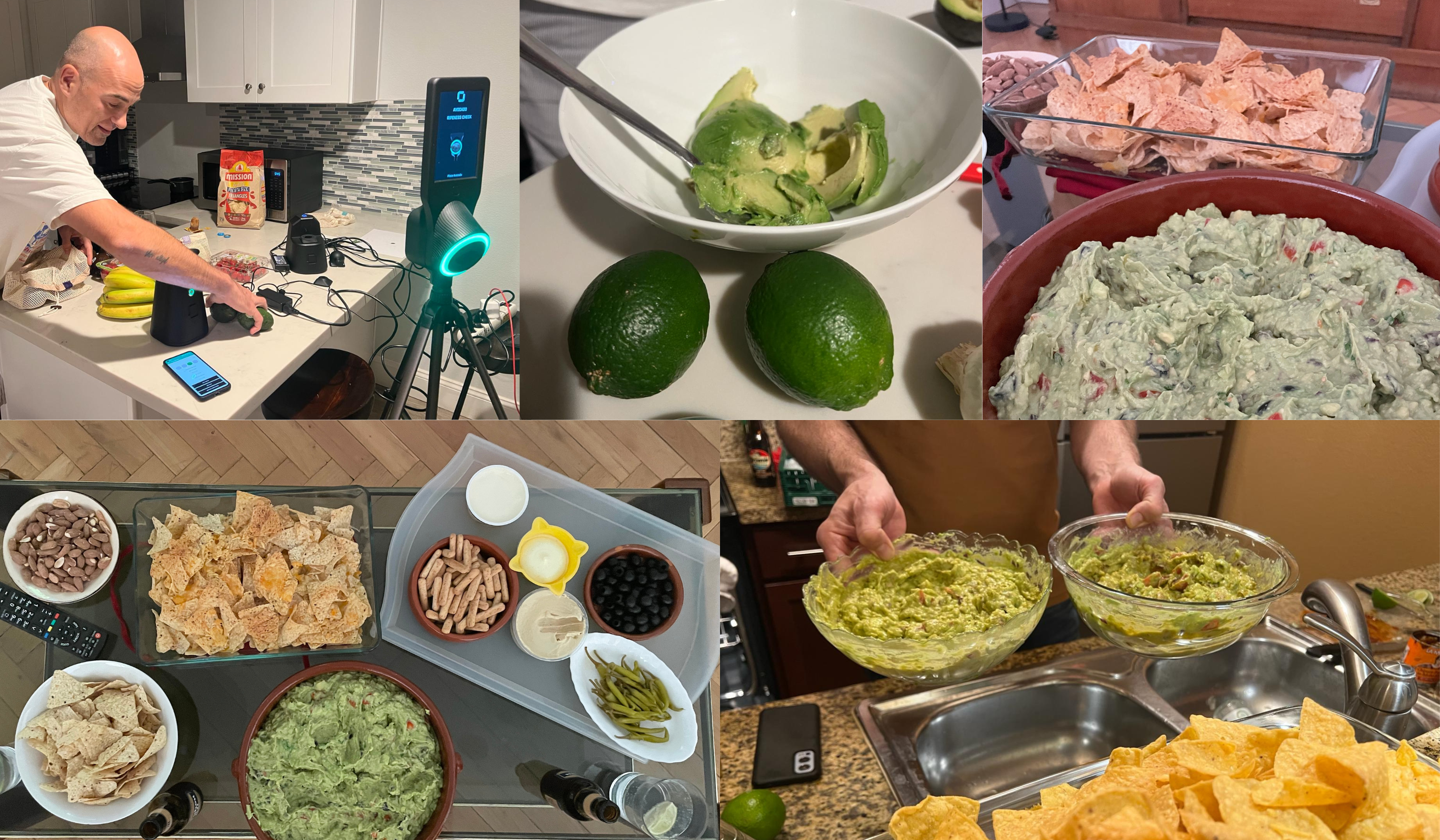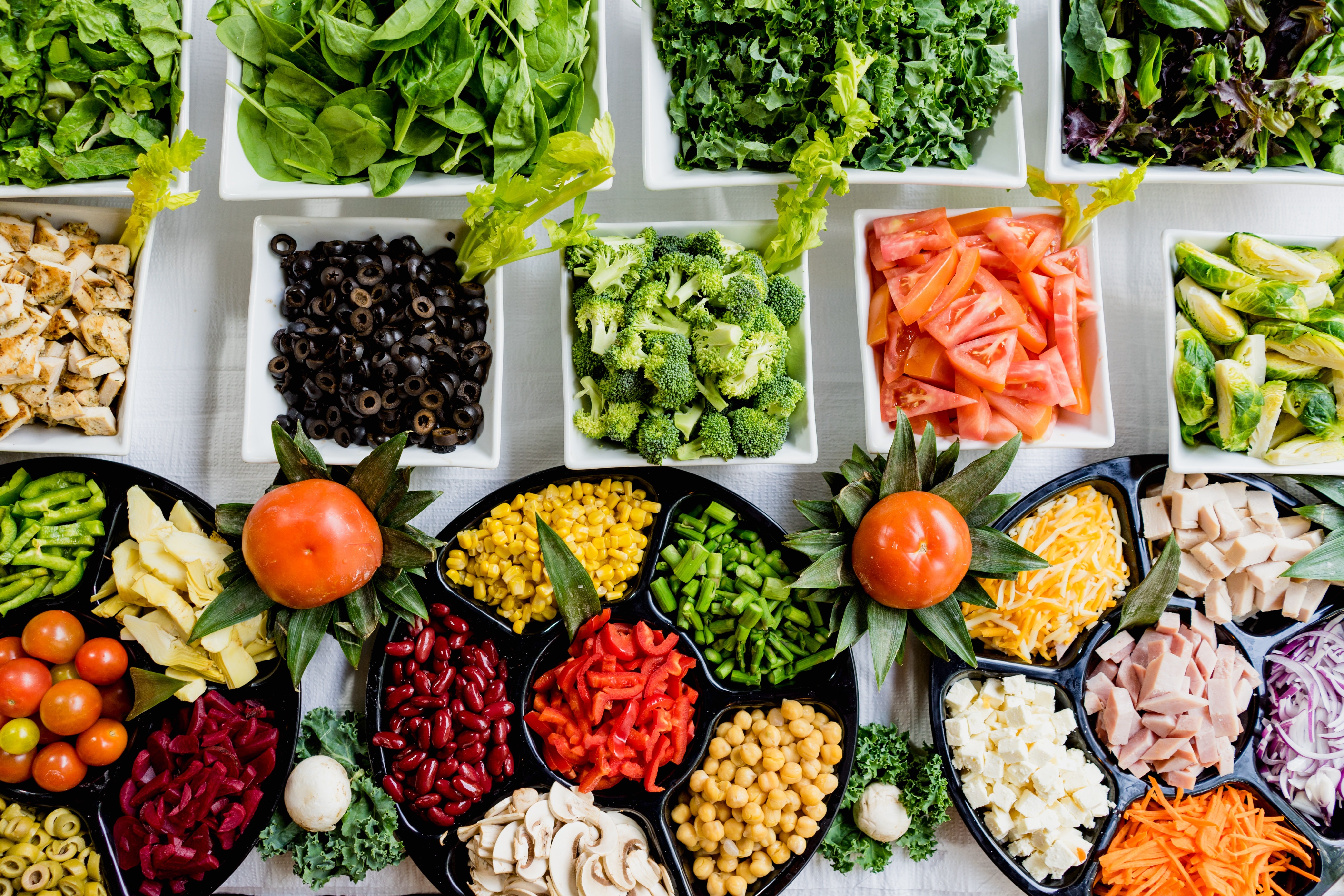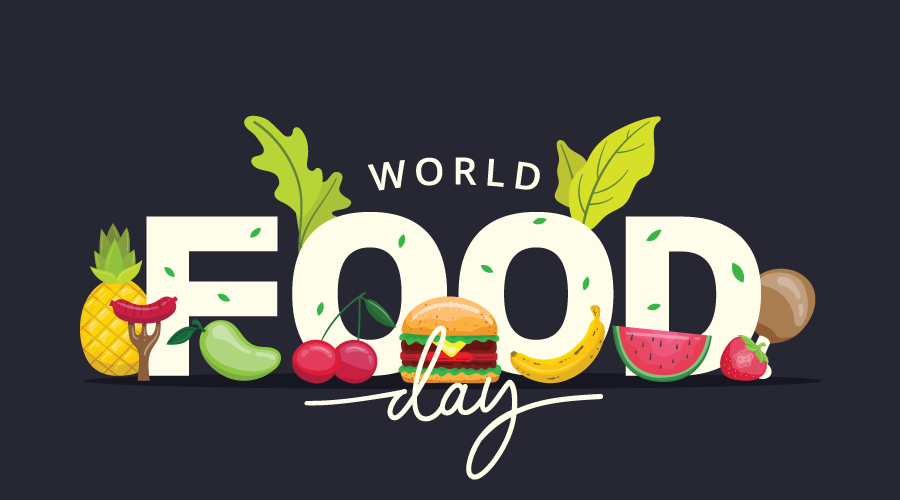
25 May 2023
doorOneThird
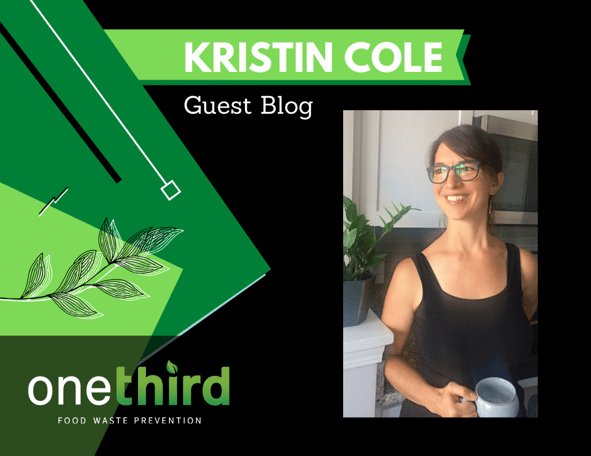
Plastic and food waste often go hand in hand but can be tricky to navigate. How do we reduce plastic and food waste in our own kitchens? When we shop for groceries? When we’re just out and about?
Kristin Cole is a chef, educator, and coach who inspires others to think confidently in their kitchens and adopt the practical skills of simplicity and resourcefulness.
She encourages her students to lead with intuition and connect with nature in a world of overwhelming choices. It is through small lifestyle shifts that she sees the potential for change to our wellbeing and that of the planet. The reduction of food waste is at the core of Kristin’s work—from selecting and storing ingredients to preparing healthy meals and reinventing leftovers. She is a graduate of Williams College and ALMA Culinary School in Italy.
Kristin’s guest blog was born from email correspondence with OneThird.
OneThird:
Hi Kristin, read through some of the blogs on your website. Really liked the July 9 article about food waste (might be biased).
Sounds like you have a lot of ideas for things you could help us learn about. Excited to learn more about your work (and read more of your blogs!) What if we turned our email correspondence into a blog post?
Kristin Cole:
Glad to see OneThird is doing some cool work in the field of food waste. We’re all in it together whichever angle we come from! I’m incredibly passionate about it from the home cook perspective. I love sharing my tools for shopping, storing, and using up what we have with a more practical mindset. Beeswax wraps are some of my favorite unsung heroes for prolonging the shelf-life of produce once it reaches our homes, as they so perfectly mimic nature’s skin.

Re: Plastic and Food Waste at Home
OneThird:
Your new post mentions wrapping veggies in paper towels and a plastic bag in order to prolong their shelf life. For those of us trying to move away from plastic, beeswax wraps and reusable produce bags are a good start.
BUT, given how much plastic we all have in our systems, and how related food waste and plastic waste are, if we have the means to be conscious about it and make an effort in response, that’s a good start. Would love to hear any thoughts you have on that relationship between plastic and food.
Kristin Cole:
Using plastic and paper towels to keep veggies fresh is a valid point. I encourage people to reuse their plastic bags and not use paper towels (I don’t even own any!). I think sometimes, my overriding passion for food waste encourages me to meet people where they’re at in their packaging game, even if that means they’re still using paper towels and plastic.
OneThird:
Think I’ve come to the same conclusion about meeting people where they’re at with packaging. Arthur Ashe said, “Start where you are, use what you have, do what you can.”
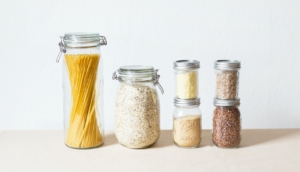
Re: Plastic, Food Waste, and the Climate Crisis
Kristin Cole:
To be honest, both food waste and plastic waste are equally pressing environmental concerns, but which one is more urgent? I don’t know with certainty. From my understanding of Project Drawdown and the extremity of methane emissions from rotting food waste, I believe that preventing food waste is actually more crucial to solving our immediate climate crisis (it’s in the top 5 solutions). Or if prevention isn’t an option, we can at least turn that food surplus into rich compost.
OneThird:
Exactly right! Both food waste and plastic waste are serious environmental concerns, but food waste actually is more crucial. The good news there is that as we reduce food waste, we will reduce plastic waste simultaneously, given how much we use plastic to package wasted food.
Kristin Cole:
The article about microplastics is haunting. We are literally inundated in plastic without even knowing so and that is concerning. But it also allows people to ignore the problem more easily. When we “throw away” plastic or even send it out of our dirty laundry water, it leaves our possession and goes into the landfill where we never see it again. That means it’s gone forever, right?! Same with food waste – toss it in the trash and it’s “gone”. This linear mindset must absolutely change to one of circularity. Educating and mindset shifts are our strongest tool for enacting change on this planet, at least from the consumer side.
Producers’ Use of Plastic Packaging
Kristin Cole:
On the producer side, companies have to (finally!) take responsibility for their packaging and step up to the plate. NOT put that responsibility on the buyers who then play into a broken recycling system (I’ll spare you the rant). I know that a lot of progress is being made with circular food delivery systems (like LOOP) or plant-based packaging. Even so, I’ve heard companies like ReGrained complain that their compostable packaging actually led to their granola bar degrading faster, which in turn, led to more food waste! What a headache. They had to go back to their larger mission of food waste and tackle the packaging issue more carefully. So back to plastic for now. These are really competing challenges for companies and consumers alike!
OneThird:
Right, the producers! Can’t wait for more companies to consider more sustainable packaging. Remember when Whole Foods sold peeled oranges in plastic containers? That hurt.
I have heard, though, that some of the biodegradable packaging options actually just end up as microplastics anyway. On that note, also saw an article about how industrial composters don’t necessarily want people composting compostable eating utensils because we make mistakes and plastic utensils end up in the compost bins. I’m sure you can follow the crumbs: if there’s plastic in the compost, it can’t be sold as organic. Then, the plastic ends up in our food supply, meaning our produce has microplastics in it right off the bat. Room for improvement.
Kristin Cole:
I’m glad to know there are so many companies out there using 100% compostable in their entire line of single-use products. But… even there, I’m still a skeptic. Look what happened to Sweetgreen with what they believed to be legit compostable containers. Mmm, not so much. With all the innovation in plant-based packaging products, there’s also the risk for introducing new materials and chemicals into the waste stream.
Reducing Plastic Waste as a Consumer
Kristin Cole:
On a personal level, when I lived in California and Oregon, I was able to prioritize both food waste AND plastic prevention because I intentionally created the systems that allowed me to do so. Yes, it was hard to set everything up at first but once I was in the flow, it couldn’t have been easier. I was also lucky to be living in progressive cities that focus heavily on the wellbeing of people and the planet.
My article on tiny living touched upon a lot of my techniques for adopting that lifestyle at home but my mindset also extended into leisure and travel where I would never be without my mini bamboo utensil set, stainless steel snack boxes, or cloth napkins. But really, anything you bring from home (a single metal fork or spoon for example) to avoid using more single-use plastic out there is amazing. I love seeing others adopt these small, actionable steps.
Farmers’ Markets and Food Co-ops
During my Farmers Market outings, I would bring my own shopping bags and reusable produce bags for loose produce. I would say most vendors either sell loose ingredients from their beautiful display or provide a paper bag or compostable tray if needed. The only time I accepted plastic was in the vacuum-sealed grass-fed meat that I would occasionally buy.
When I shopped at the local Food Coop for other household items, I would also bring my set of bags along with a ‘bulk kit’ that my wife and I created for ease and efficiency. It was a simple box filled with all of my empty jars that needed refilling of grains, nuts, flours, etc, some smaller jars for loose spices, and bottles of various sizes to house the honeys, olive oils, vinegars, aminos, etc from the liquid area. All of the jars had been pre-weighed and labeled with the product SKU number of what I would normally buy (I left some blank too for surprise finds!)
This system was incredibly easy, cost-effective, and zero-waste. I remember so many shoppers and cashiers alike asking about the kit and I took every opportunity to inspire by example. Of course, avoiding plastic in the inner aisles or frozen section is sometimes unavoidable so whatever I did generate, I’d always try to reuse in my home or to pick up my dog’s poop. It’s nearly impossible to have a 100% plastic-free grocery shopping experience but I sure did my best.
Plastic-Free Grocery Shopping During COVID
OneThird:
Now that you’re not living in a tiny home, how do you navigate shopping in grocery stores full of plastic? Do you avoid those stores altogether/shop with plastic-free stores or stores that primarily sell in bulk? Bet you still avoid plastic as much as possible, regardless. Still use the jar system?
Kristin Cole:
My journey has become more challenging in a new city all while COVID was permeating our lives and the industry was simultaneously encouraging single-use plastics in full force. It’s been disheartening to see all of the progress made on plastic bag and straw bans along with novel take-out concepts (here in Durham we have Green to Go for closed-loop take out containers) just fall to the wayside as plastic became the new hero against the coronavirus. I personally think it was excessive and, unfortunately, this fear mindset has sunken in over the last 8 months as people are convinced that plastics are absolutely necessary to stay safe in our vulnerable world. So retraining people or redesigning the system entirely will be its own lengthy process.
To be honest, we’re all navigating these new, unchartered waters and doing our best within an already complex food system. But those of us who work in the industry will continue to fight – we’re a relentless bunch.
Changes Due to the Pandemic
I used to truly enjoy grocery shopping pre-pandemic when I could take my time, stroll through the aisles and admire new products, read labels, and even sample from local vendors (that was a big bonus in a food coop – exposure to small, conscious CPG startups). All that has changed. Now it’s about sterility, efficiency, distancing, single-use everything, and shutting down of bulk sections and self-serve food stations. It feels like a get-in, get-out, be-damned-if-you-don’t-have-a-shopping-list experience in order to keep the stream of people moving.
As we all adjust to the changing rules at grocery stores, I’m learning to be gentle with myself and to accept that some of my choices currently may not align with even those from a year ago. Instead of bringing all of my jars to the store, I am ok with buying what I can either from the pre-packaged bulk areas or just buying larger quantities in general and bringing it home to redistribute into my limited glass jars.
Same goes with spices. It helps to maintain the comfort of my system even though the process of getting there is slightly different. Yes, much more plastic is generated but I try to reuse what I can. I look at it all in terms of balance and find other ways to be more sustainable in my practices. Farmers Markets, for example, still sell produce without packaging and allow you to bring your own reusable bags so I try to support local every week. Furthermore, since I don’t have a compost pile, I send my inedible food scraps and meat bones (after I’ve made stock) to a local service that replaces your household bin each week and supplies me with fresh compost to keep or donate to community gardens.
In Person vs. Online Shopping
I am one to always shop in person, not online. Tried it too many times, even with Imperfect Foods, and I am left disappointed with the packaging and/or poor quality of the produce every time! So let’s just say it’s personally been a tough transition but I am equally thrilled to see home cooking and food waste prevention at the top of people’s awareness.
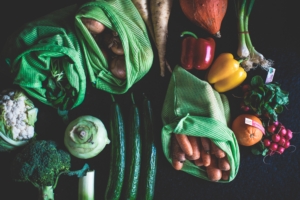
Re: How Do I Become Waste-Free? Where Do I Start?
OneThird:
There are so many things to be doing for so many different causes right now. When it comes to building waste-free lifestyles, where do we start? What are manageable first steps that you recommend for those of us who have the means to lead more sustainable lives (and maybe many of us don’t realize that we actually do have the means)? How do we, again, start where we are, use what we have, and do what we can? Do we start with our eating habits or with our kitchen practices or our shopping rituals?
I’ve definitely felt like I didn’t know where to start. My first step was meal planning. Reusable grocery and produce bags came next because I knew how much food I’d be buying. After that, the steppingstones for continuing on this path just fell into place.
Where do we start with waste-free living?
Kristin Cole:
Clearly, it is such an overwhelming landscape at the moment! I admire your process of selecting one area and letting it flow from there. That is exactly what I would advise. And also add that we should listen to what is intuitively drawing us in at the moment and take a very small step in that direction. Just start. Any action is well-served right now as people tend to freeze up when they are overwhelmed and get stuck in analysis paralysis (I’ve totally been there).
Start With Ourselves
Kristin Cole:
Once we move forward, we build more interest in other interconnected topics and the positive effects for ourselves, the community, and the environment continue to snowball. I’d say the most important thing above all else is to START WITH OURSELVES. Be the change you want to see. Serve as an example and people will be curious and want to learn from you. Your practices will reach far and wide and actually promote more good than you know.
Positive Practices
I’d also advocate adding in positive practices, rather than coming from a mindset of restriction and deprivation. We must gently add in the good stuff whether it be a small amount of fermented foods to our meals, or bringing a reusable bag with us, or using healthier oils like olive or coconut in our cooking instead of focusing on what we need to get rid of or what we’re doing wrong. The negative stuff will easily fall away (ie. processed foods, plastic bags, seed oils, in the above examples) and the practices will continue to build on one another.
Interconnected Good Habits
I’ve seen my habits in one area of life easily translate to other areas. For example, by cleaning up my kitchen pantry and adding in nutrient-dense, wholesome foods; Now I’ve done the same in my bathroom to the point where I now make all of my own products (deodorant, toothpaste, shampoo), which is enjoyable, easy, cost-effective, and safe. This stemmed from a focus on the healing power of coconut oil, ACV, baking soda, sea salt, and other healthy ingredients, not necessarily from removing the chemicals from store-bought products. Alas, my point is to build (and build incrementally!), not subtract when it comes to making change.
More from Kristin Cole
More from OneThird
